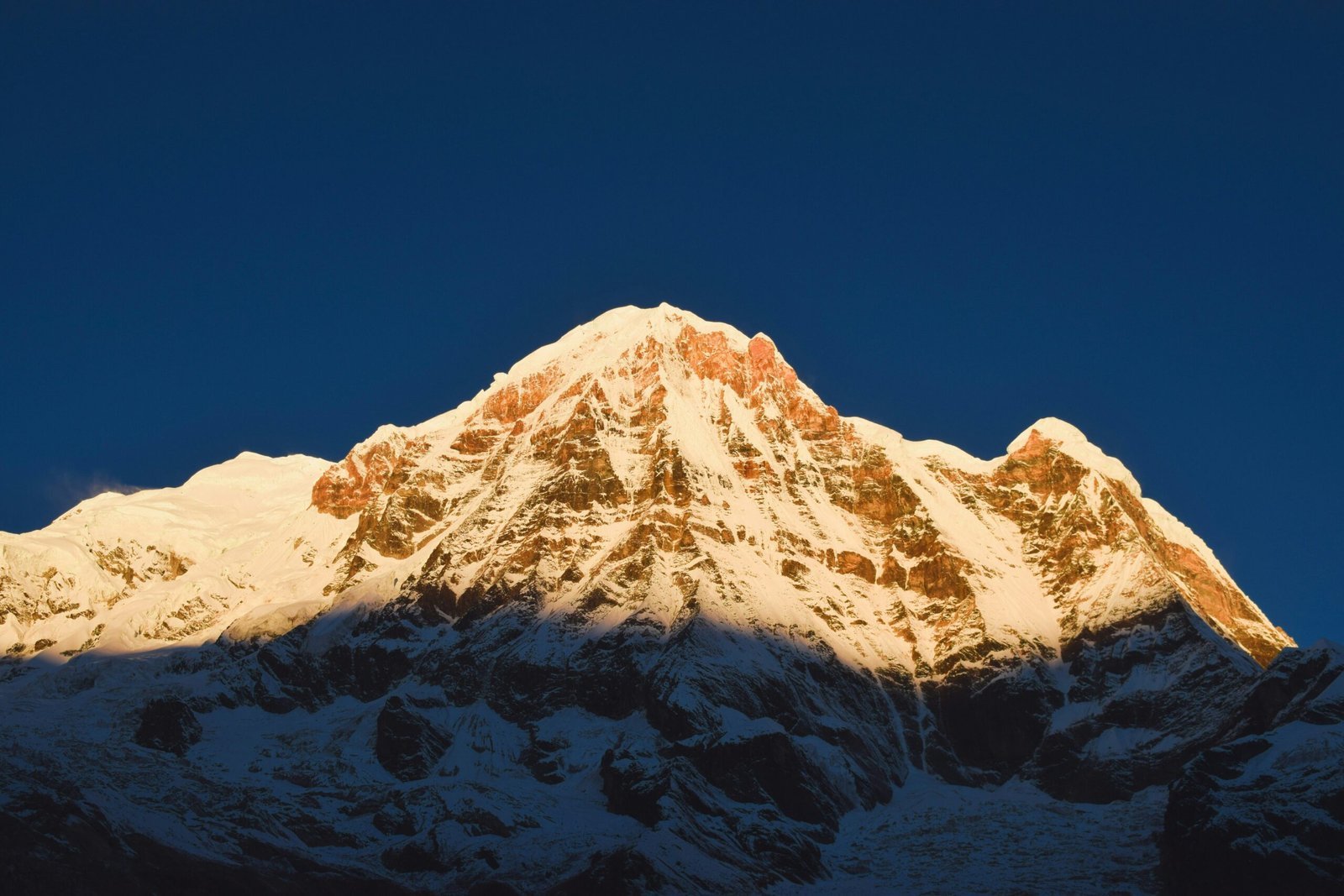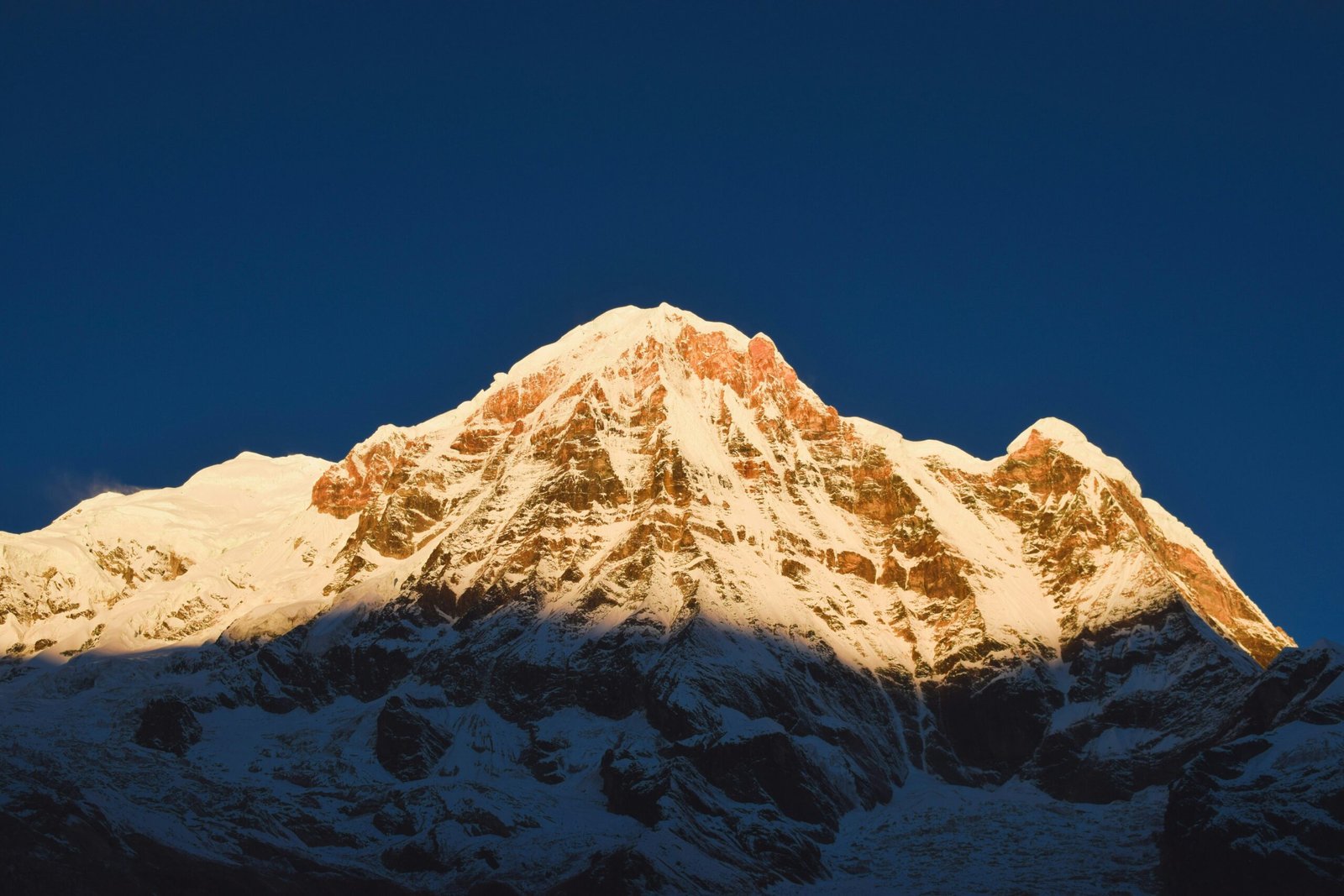
Introduction to Annapurna South
Annapurna South, also known as Annapurna Dakshin or Moditse, is a distinguished peak situated in the Annapurna mountain range of the Himalayas in Nepal. With an imposing height of 7,219 meters (23,684 feet), it stands as a significant yet often overshadowed sibling to the more renowned Annapurna I. However, Annapurna South’s formidable presence and unique set of challenges make it a noteworthy peak in its own right.
Geographically, Annapurna South is located to the south of the Annapurna massif, forming a crucial part of this complex and majestic range. The Annapurna massif itself is part of the larger Himalayan range, which stretches across five countries: Bhutan, India, Nepal, China, and Pakistan. Within Nepal, the Annapurna region is one of the most trekked and admired areas, drawing thousands of adventurers from around the globe each year. Despite its proximity to the more famous Annapurna I, Annapurna South commands respect and admiration from mountaineers and trekkers for its rugged terrain and the technical difficulties it presents.
The significance of Annapurna South within the Annapurna massif cannot be overstated. This peak not only contributes to the overall grandeur and complexity of the range but also adds to the mountaineering challenges that define the region. Its towering height and challenging routes require a high level of skill, preparation, and respect for the natural forces at play. Climbers who attempt Annapurna South must be prepared to face treacherous weather conditions, steep ascents, and the ever-present risk of avalanches.
In conclusion, while Annapurna South may be considered a sidekick to the more illustrious Annapurna I, it is by no means less dangerous or significant. Its geographical prominence, coupled with the challenges it poses, makes it a vital and formidable peak within the Annapurna range. The mountain’s allure lies in its combination of beauty, danger, and the sense of accomplishment it offers to those who dare to take on its slopes.
Geological Features and Climbing Routes
Annapurna South, a prominent peak in the Annapurna massif, is renowned for its formidable geological features. The mountain is characterized by steep slopes and sharp, knife-edge ridges that present significant challenges to climbers. The rugged terrain is further complicated by treacherous icefalls and expansive glaciers, which contribute to the peak’s reputation for being perilous. The glaciers on Annapurna South, such as the South Annapurna Glacier, are vast and riddled with crevasses, making navigation precarious and requiring meticulous planning and expertise.
The rock formations of Annapurna South are primarily composed of sedimentary rock, which adds another layer of complexity to climbing endeavors. These rocks, often loose and brittle, increase the risk of rockfall, demanding climbers to exercise extreme caution. The geological instability, combined with severe weather conditions, amplifies the technical difficulties faced during ascents.
Several climbing routes on Annapurna South have garnered attention over the years, each with its own set of challenges. The South Face route, one of the most direct paths to the summit, is notorious for its steep gradient and technical demands. Climbers on this route must navigate through a series of icefalls and seracs, with the risk of avalanches always looming. Despite its dangers, the South Face has seen numerous successful ascents, with climbers drawn to its direct approach to the summit.
The Northwest Ridge is another prominent climbing route, known for its prolonged exposure and demanding ice and rock sections. This route requires climbers to tackle mixed terrain, including ice walls and rocky outcrops, under often unpredictable weather conditions. The historical ascents of the Northwest Ridge have highlighted the route’s difficulty, with many expeditions encountering significant challenges due to the harsh environment and technical nature of the climb.
Overall, Annapurna South’s geological features and climbing routes present a formidable challenge to mountaineers. The combination of steep slopes, sharp ridges, and treacherous icefalls, along with the technical difficulties of its climbing routes, cements Annapurna South’s status as a peak that commands respect and meticulous preparation from those who dare to scale its heights.
Historical Ascents and Notable Climbers
Annapurna South, a majestic peak in the Annapurna range, has a storied history of ascents. Its first successful climb was achieved in 1964 by a determined Japanese expedition. This landmark achievement opened the gates for many climbers who sought to conquer its formidable slopes. The expedition, led by Yuko Maki, set a precedent for future climbers by meticulously planning their route and adapting to the harsh conditions that the mountain presented.
In the following decades, Annapurna South attracted mountaineers from around the globe. Notable climbers like Reinhold Messner, who is often regarded as one of the greatest mountaineers of all time, have left their mark on this peak. Messner’s climbs in the Annapurna region, although not directly on Annapurna South, have significantly contributed to the understanding and respect for the entire range.
The evolution of climbing techniques and equipment has played a critical role in the increasing success rates of ascents. In the early days, climbers relied heavily on rudimentary gear, which posed significant challenges and risks. However, advancements in technology have led to the development of more sophisticated climbing equipment, enhancing safety and efficiency. Modern climbers now utilize lightweight, high-strength materials for ropes and protective gear, alongside advanced weather forecasting tools which allow for better planning and risk management.
Despite these advancements, Annapurna South remains a perilous climb, demanding respect and caution from those who attempt it. The mountain’s treacherous conditions, including unpredictable weather and avalanches, have led to numerous unsuccessful attempts and tragic losses. Each successful ascent is a testament to the climbers’ skill, determination, and the relentless human spirit that continually pushes the boundaries of exploration.
The history of Annapurna South is a rich tapestry woven with stories of triumph and tragedy. It stands as a symbol of both the allure and the dangers of high-altitude mountaineering. As climbers continue to be drawn to its challenging slopes, Annapurna South will undoubtedly remain a significant chapter in the annals of mountaineering history.
The Dangers of Annapurna South
Annapurna South, despite being overshadowed by its more famous counterpart, Annapurna I, presents significant dangers to climbers. This formidable peak, standing at 7,219 meters, is fraught with numerous hazards that make it a perilous undertaking for mountaineers. One of the primary risks associated with Annapurna South is the prevalence of avalanches. The steep slopes and heavy snowfall create an unstable environment where avalanches can occur without warning, posing a serious threat to anyone on the ascent.
Another critical danger is the presence of crevasses. These deep fissures in the glacier surface are often hidden beneath a thin layer of snow, making them difficult to detect. Falling into a crevasse can result in severe injury or even death, especially if the climber is not promptly rescued. The treacherous terrain of Annapurna South necessitates constant vigilance and careful navigation to avoid these concealed traps.
Severe weather conditions further compound the challenges faced by climbers on Annapurna South. The mountain is subject to sudden and extreme weather changes, including high winds, heavy snowfall, and sub-zero temperatures. These harsh conditions not only make the climb more physically demanding but also increase the risk of frostbite, hypothermia, and other cold-related illnesses. Climbers must be well-prepared and equipped to handle these adverse weather scenarios to ensure their safety.
Statistics on accidents and fatalities highlight the dangerous nature of Annapurna South. Although less frequented than Annapurna I, the mountain has seen its share of tragic incidents. Over the years, numerous climbers have lost their lives or sustained serious injuries while attempting to conquer this peak. The combination of avalanches, crevasses, and severe weather conditions contributes to a high risk factor, underscoring the need for meticulous planning and caution.
In conclusion, while Annapurna South may not have the same level of fame as Annapurna I, it is equally treacherous. The mountain’s inherent dangers, including avalanches, hidden crevasses, and unpredictable weather, demand respect and careful consideration from those who dare to challenge its slopes. The statistics on accidents and fatalities serve as a stark reminder of the risks involved, emphasizing the importance of preparation and vigilance for anyone aspiring to summit Annapurna South.
Environmental and Climatic Conditions
Annapurna South, while often overshadowed by its more famous neighbor, Annapurna I, presents its own set of environmental and climatic challenges that are critical for any climbing expedition. Understanding these conditions is essential for ensuring both the safety and success of any endeavor on this formidable peak.
The weather patterns around Annapurna South are marked by significant variability, influenced by its high altitude and geographic location in the central Himalayas. The region experiences a monsoon season from June to September, characterized by heavy rainfall and increased risk of landslides, making it an unsuitable period for climbing. Post-monsoon, the weather stabilizes, offering clearer skies and more predictable conditions, making autumn (September to November) and spring (March to May) the preferred seasons for mountaineering activities.
Seasonal variations further complicate the climbing conditions. During the winter months, from December to February, temperatures plummet, and heavy snowfall can create hazardous conditions, including avalanches. Conversely, the pre-monsoon and post-monsoon periods provide relatively stable weather, although climbers must still be prepared for sudden changes, including strong winds and cold temperatures, which are common at high altitudes.
Climate change has also begun to impact the region, altering weather patterns and increasing the unpredictability of conditions. Glacial retreat and the thinning of ice formations have been observed, which can affect the stability of climbing routes and increase the risk of crevasses and icefalls. These changes necessitate a higher level of preparedness and adaptability from climbers.
The Annapurna Conservation Area, which encompasses Annapurna South, is rich in biodiversity, hosting a variety of flora and fauna. The lower altitudes are home to dense forests of rhododendron, oak, and pine, while higher elevations support alpine meadows and hardy shrubs. This biodiversity extends to the fauna, with species such as the Himalayan tahr, snow leopard, and various bird species inhabiting the region. The conservation area plays a crucial role in preserving this unique ecosystem, which is under increasing threat from climate change and human activities.
Preparation and Training for Climbers
Climbing Annapurna South demands rigorous preparation and training, given its challenging terrain and high altitude. A successful ascent hinges on a climber’s physical fitness, technical skills, acclimatization strategies, and proper gear. Unlike casual treks, summiting Annapurna South requires a structured fitness regime that builds endurance, strength, and cardiovascular health. Climbers should incorporate activities such as running, cycling, and weight training into their routine, focusing on core strength, leg muscles, and overall stamina. High-intensity interval training (HIIT) can also be beneficial for improving aerobic and anaerobic capacity.
Technical skills are equally crucial for tackling Annapurna South. Prospective climbers should hone their abilities in rock climbing, ice climbing, and crevasse rescue techniques. Practicing these skills in varied conditions will prepare them for the unpredictable nature of the mountain. Additionally, familiarity with using equipment such as crampons, ice axes, and ropes is essential. Enrolling in mountaineering courses or joining guided expeditions can provide hands-on experience and expert guidance.
Acclimatization is a critical component of high-altitude climbing, as it helps prevent acute mountain sickness (AMS) and other altitude-related issues. Climbers should follow a gradual ascent profile, allowing time for their bodies to adjust to decreasing oxygen levels. Employing the “climb high, sleep low” strategy, where climbers ascend to higher altitudes during the day and descend to lower altitudes to sleep, can enhance acclimatization. Staying hydrated, maintaining a balanced diet, and monitoring health symptoms are also vital practices.
Lastly, having the right gear and equipment is non-negotiable for a successful expedition. Essential items include a high-quality mountaineering jacket, insulated layers, technical climbing boots, and a reliable sleeping bag rated for cold temperatures. Safety gear such as helmets, harnesses, and avalanche transceivers are also imperative. Ensuring that all equipment is tested and in good condition before the climb can prevent potential mishaps.
In essence, thorough preparation and training not only increase the chances of reaching Annapurna South’s summit but also ensure a safer and more enjoyable climbing experience. By focusing on fitness, technical skills, acclimatization, and gear, climbers can tackle the formidable challenges posed by this majestic peak.
The Role of Sherpas and Local Communities
The success of any climbing expedition to Annapurna South is inextricably linked to the indispensable support provided by Sherpas and local communities. These individuals play a critical role, offering their profound expertise and unwavering dedication to ensure the safety and efficiency of climbers. Sherpas, hailing from the Himalayan region, possess unparalleled knowledge in high-altitude climbing. Their familiarity with the terrain, weather patterns, and potential hazards makes them invaluable assets for any expedition.
Beyond their technical skills, Sherpas serve as cultural ambassadors, enriching the climbing experience with their deep-rooted traditions and practices. Their reverence for the mountains, coupled with their spiritual beliefs, often provides climbers with a unique perspective on the challenges and rewards of mountaineering. This cultural exchange fosters a sense of respect and appreciation among climbers, enhancing the overall expedition experience.
The contributions of local communities extend beyond the physical and technical support during climbs. Economically, mountaineering has become a vital source of income for many households. Jobs such as porters, guides, and cooks provide much-needed employment opportunities, bolstering the local economy. The influx of climbers also stimulates local businesses, from lodging and food services to souvenir shops, creating a ripple effect of economic benefits.
Socially, the interaction between climbers and local communities fosters mutual respect and understanding. The shared experiences and collaborative efforts during expeditions often lead to lasting bonds, bridging cultural divides. This symbiotic relationship highlights the importance of community involvement in mountaineering, ensuring that the benefits are widely distributed and that the local culture and traditions are preserved.
In essence, the role of Sherpas and local communities in climbing expeditions to Annapurna South is multifaceted and invaluable. Their contributions not only enhance the success and safety of the climbs but also enrich the cultural and economic fabric of the region. The symbiotic relationship between climbers and these local stakeholders underscores the collaborative spirit essential for overcoming the formidable challenges posed by Annapurna South.
Future Prospects and Conservation Efforts
As the allure of climbing lesser-known peaks such as Annapurna South increases, so does the imperative to balance this interest with environmental conservation and sustainable tourism practices. The future prospects for climbing Annapurna South are promising, with advancements in climbing technology and safety measures playing a significant role.
Modern climbing gear has seen substantial improvements, providing enhanced safety and comfort for climbers. Innovative materials and designs for equipment such as crampons, harnesses, and ropes have significantly reduced the risks associated with high-altitude expeditions. Additionally, advancements in weather forecasting technology enable climbers to better prepare and avoid hazardous conditions, thereby increasing the success rates of summit attempts.
Safety measures have also evolved, with a strong emphasis on education and training. Climbing expeditions now often include mandatory pre-climb training sessions focusing on critical skills such as avalanche rescue and high-altitude acclimatization. These measures not only ensure the safety of climbers but also mitigate the environmental impact by reducing the likelihood of accidents and emergency interventions.
Conservation efforts in the Annapurna region are equally crucial. The Annapurna Conservation Area Project (ACAP) has been at the forefront of preserving the natural beauty and ecological balance of the region. Initiatives such as waste management programs, reforestation projects, and wildlife protection schemes aim to minimize the environmental footprint of climbing activities. Local communities are also actively involved in these conservation efforts, promoting sustainable tourism practices that benefit both the environment and the local economy.
Looking ahead, the integration of sustainable practices in climbing expeditions is likely to become more prevalent. Eco-friendly gear, carbon offset programs, and stricter regulations on waste management are expected to be standard practices. These efforts will be crucial in ensuring that the natural splendor of Annapurna South is preserved for future generations, while still allowing adventurers to experience the thrill of its ascent.



